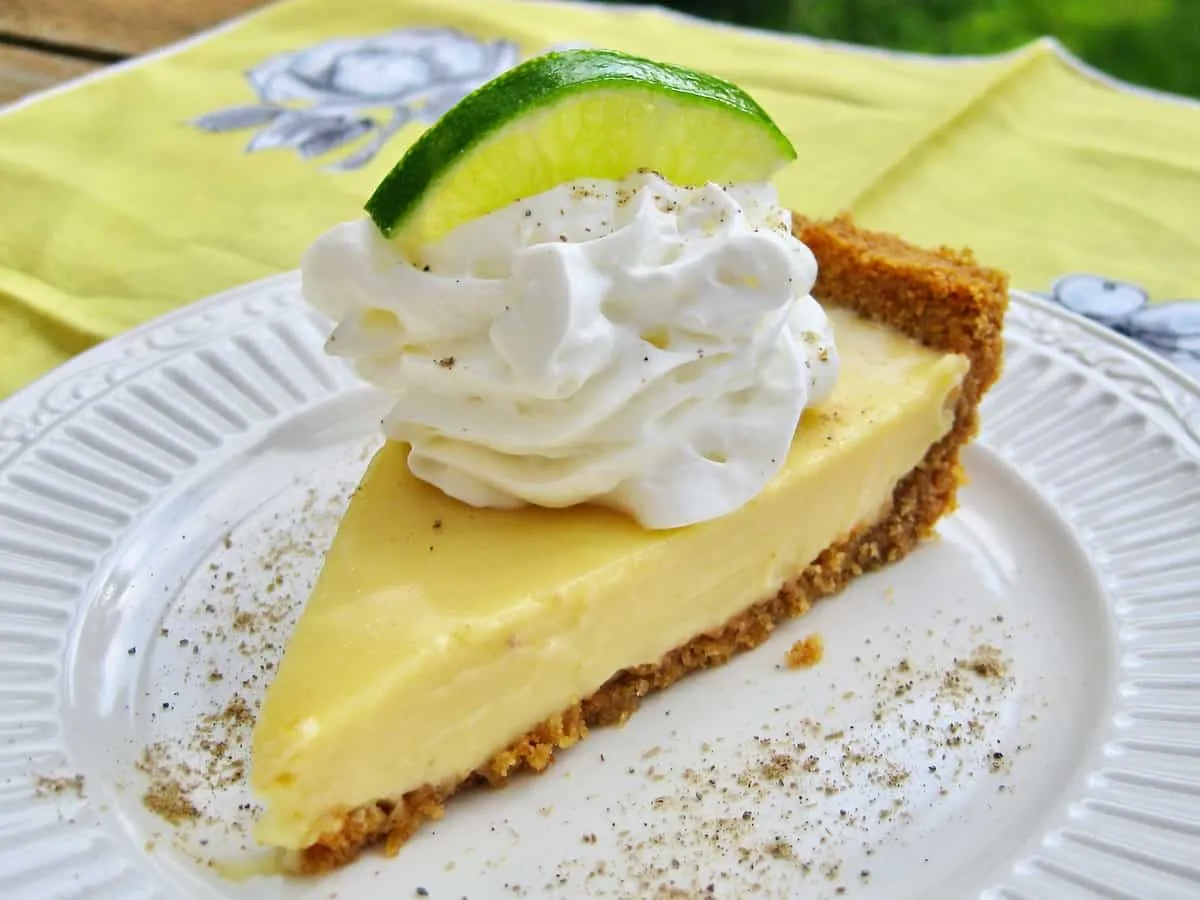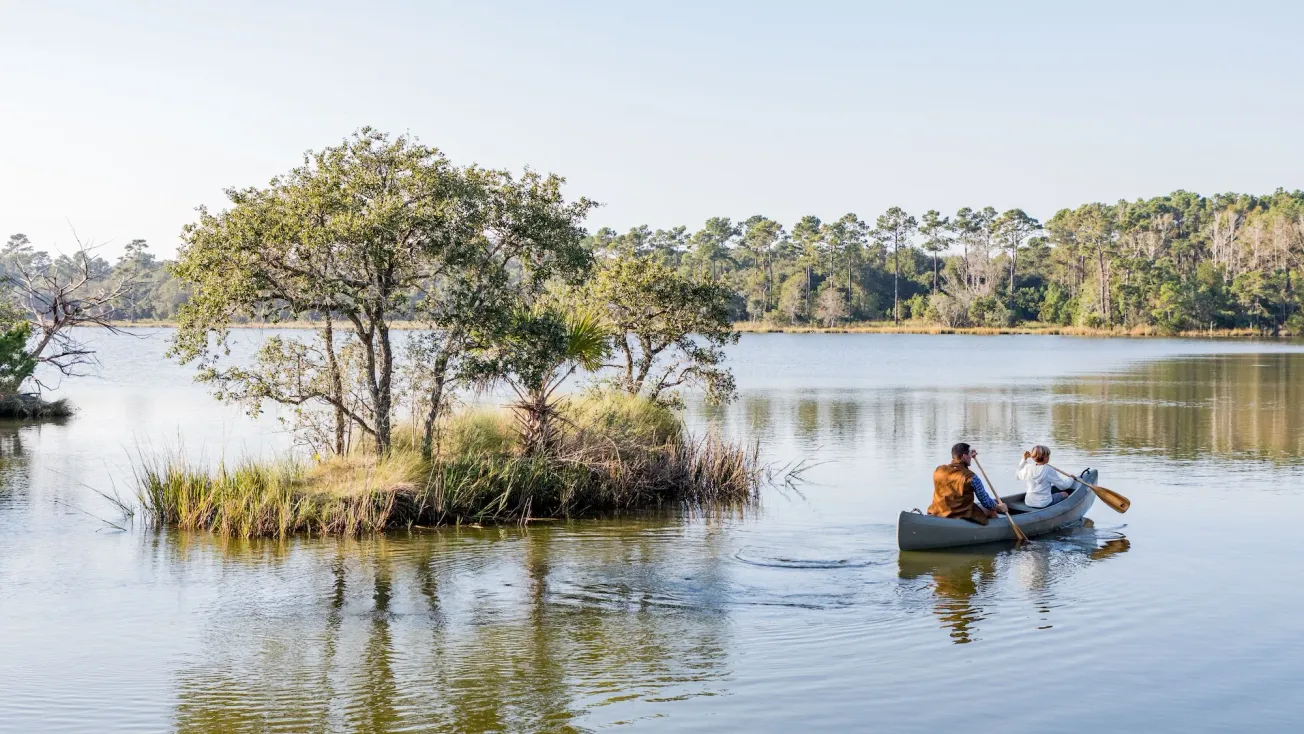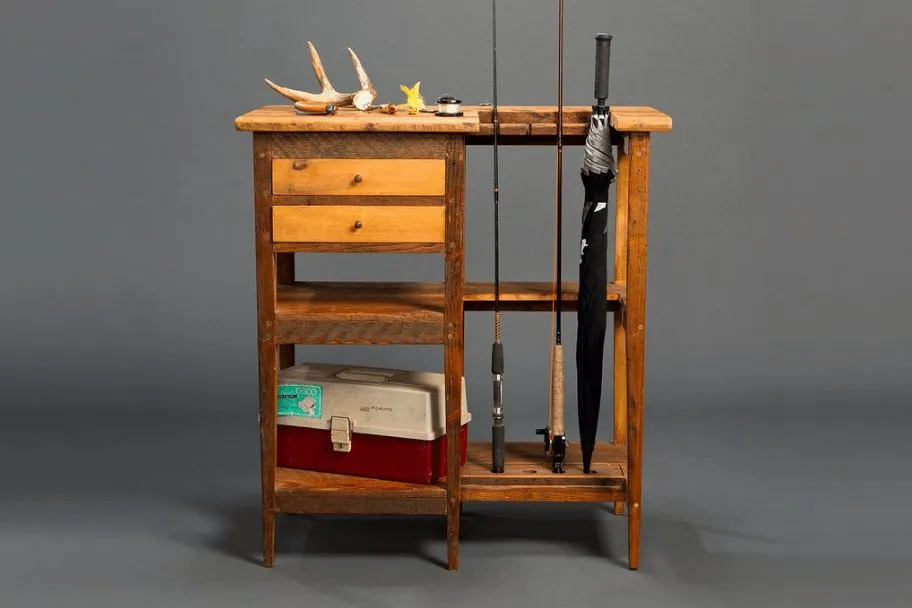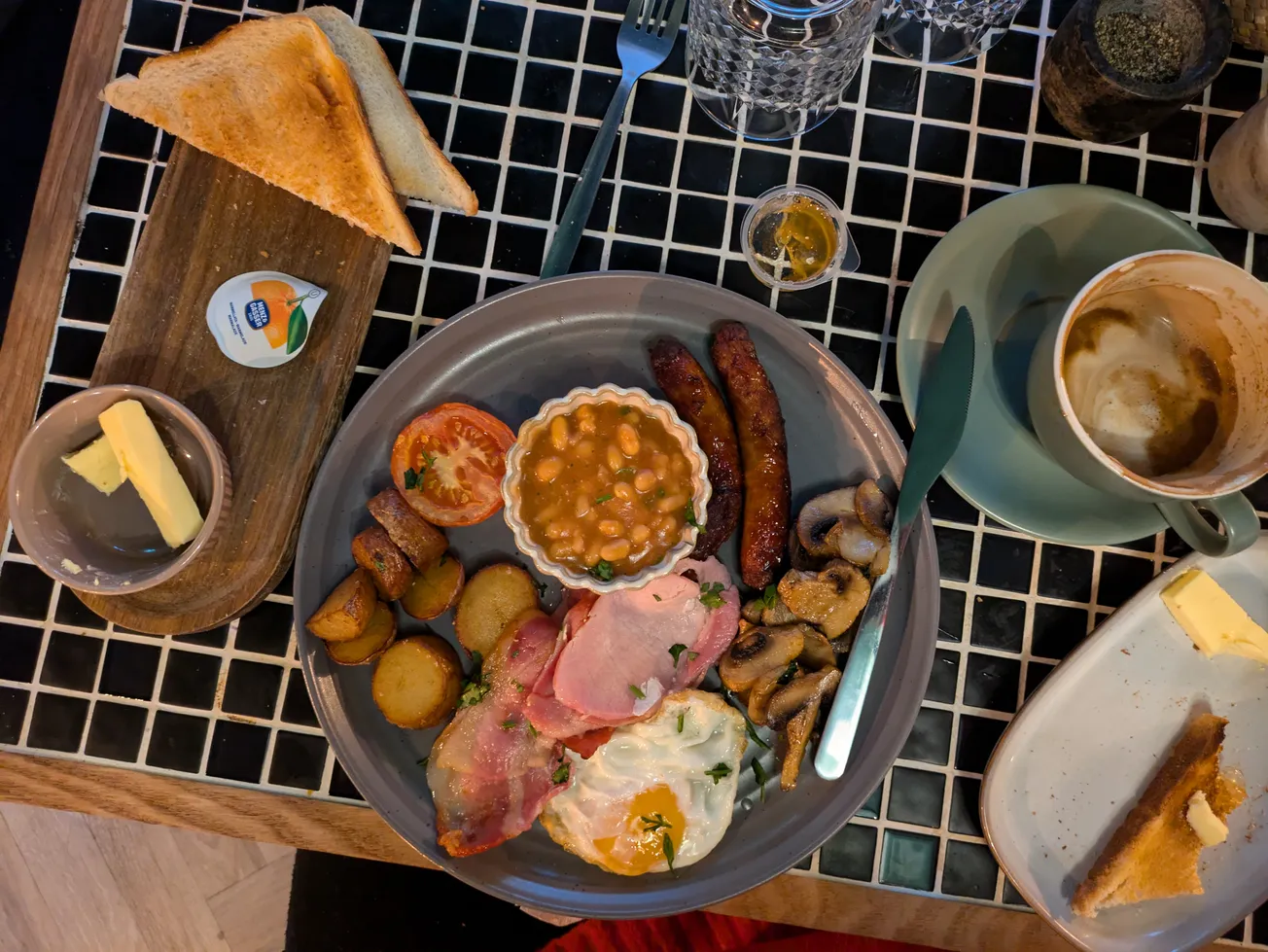Someone had to die so that we might have key lime pie, and key lime pie in its first incarnation experienced a kind of death of its own. The original pie had a life span of seventy years (1856–1926). What we eat now is a descendant of it, which is an odd thing to say about pie. After all, we imagine we could simply collect the ingredients now and that prior to 1856 a resourceful Key West cook might have assembled the ingredients herself if only she’d thought of it first. But the story of key lime pie isn’t a simple one.
We often think of recipes coalescing because of the migratory patterns of the peoples who first introduced them to new places or of indigenous ingredients like the key lime. Various version of sweet cream pie can be traced to the Shaker communities of Indiana. Apple pies or tarts have been around since the Middle Ages. Gail Borden patented sweetened condensed milk in 1854, and two years later we had key lime pie, so the birth of this pie was as much about this event in food technology as it was about the key lime.
I grew up on a picnic version of key lime pie popularized near the end of the twentieth century, after General Foods introduced Cool Whip in 1966. My grandmother blended a tub of the frozen whipped topping, a can of sweetened condensed milk, and a small Minute Maid frozen limeade and delighted us grandkids on hot summer afternoons at Lake Burton—a freshwater lake in North Georgia—with a taste that hinted at the tropical, the imagined otherness, and at margaritas we had not yet tasted. Like the pie itself and the memories of those childhood summers when we were all a tribe, to experience a thing that by nature is once here and then gone is best described as bittersweet.
The Oxford English Dictionary cites 1905 as the first year the term key lime came into usage, which seems late to me. To clarify: the key lime (Citrus aurantifolia swingle) is in a class all its own. Also called Mexican or West Indian limes, they are much smaller than Persian limes and range in size from that of a Ping Pong to a golf ball. Most of the world considers them the standard lime. It’s just the United States that now prefers Persian limes thanks to the choice in replanting after 1926.
Florida growers did not replant key limes after the 1926 hurricane that destroyed their groves. Their key limes gone, they planted Persian limes, which are more disease-resistant and heavier bearing, not to mention seedless. The key lime is more acidic than the Persian lime. The Persian lime is therefore less bitter, so to blend its juice with sweetened condensed milk, which is 40 percent sugar, isn’t as bittersweet. Now, only 10 percent of commercially available key limes in the United States come from southern Florida. The remaining 90 percent are sourced from Mexico and Guatemala, so you are far more likely to find Florida key limes growing in a Key West neighbor’s backyard than in a grocery store bin.
If you’re wondering whether it was a hurricane-related death that led to the birth of key lime pie, the answer is no. I will come to the pie’s inception momentarily. First, regarding the present: a descendant of key lime pie, my grandmother’s recipe can be found in a 1996 community cookbook called Guilty Pleasures: Collected Recipes of the Columbia Legal Association (of Columbia, South Carolina), and they called it “Payable Key Lime Pie.” It is the last of the key lime pies, the furthest one can get from the source. After all, it calls for not just cream but imitation cream.1 It would not make sense to consider my grandmother’s recipe an authentic attempt at key lime pie when looking at other iterations.
Those recipes, such as the one found in A Taste of Georgia published by the Newnan Junior Service League in 1977, call for ten egg yolks. The Taste of Georgia recipe calls also for green food coloring, an additive that makes southern Floridians wince. Authentic key lime pie, they say, is pale yellow. The other stuff is for dry-landers. What’s more, recipes vary regarding whether to bake the pie (the first key lime pies were unbaked)2 or what to use for crust (the first key lime pies were crustless). There are twists on the original as far-reaching as “David’s No Mistakin’ Bacon Key Lime Pie,” concocted by David L. Sloan, Key West’s authority on the subject of all things key lime pie. Personally, hearing of Sloan’s recipe marked for me a kind of limit to the pervasive assertion that everythingis better with bacon, but I haven’t tried it.
Bacon isn’t all Sloan came up with. In 2013, Phantom Press, which Sloan owns together with Christopher Schultz, published The Key Lime Pie Cookbook, in which he uses a formulaic approach to derive as many filling/crust combinations as possible for key lime pie. “Mix and match 20 crusts, 20 fillings, 20 toppings and 20 sauces,” Sloan writes, “to create more than 150,000 varieties of Key West’s signature dessert.” I am not sure why I find this so distasteful, except that Sloan’s other titles include Hangover Survival Guide and Don’t Do It! 101 Reasons NOT to Marry Her, the latter of which he and Schultz coauthored. Molly O’Neill’s profile of Sloan for epicurious.com, written while he was writing The Key Lime Pie Cookbook, offers some of Sloan’s story. O’Neill writes:
Sloan says it was while investigating reports of a ghost in the lavish mansion built by William “Bill Money” Curry in 1855 that [he] encountered the original recipe for Key lime pie. “I heard movement on the floor above,” he said, “but what stopped me cold was the recipe I saw in the pantry, the recipe for ‘Aunt Sally’s Key Lime Pie.'”
In case you are wondering if the movement Sloan heard on the floor above belonged to the ghost of the person who died so that we might have key lime pie, the answer is no. Or at least, I don’t think so. Curry and Aunt Sally are both figures in the history of key lime pie, but what I find endearingly half-baked about Sloan (other than his self-nomer of “Author, Entrepreneur, Paranormal Investigator”) is the way he places himself in the history of key lime pie. He goes on to say:
Most sources credit an anonymous “Aunt Sally” with inventing Key lime pie. Well, it turns out that Aunt Sally was the cook at the Curry Mansion and as soon as I saw that paper, my heart started racing and I started to shake. I knew, I just knew. It [sic] was like finding the Golden Fleece, the Holy Grail.
It’s unclear whether Sloan discovered the recipe or just saw what others already knew was there, and who granted him authority to take it. What we do know is that he quit the corporate world and moved to Key West some years ago, and he makes his living selling the stories of both key lime pie and ghosts. To Sloan, the recipe might have looked more like a golden parachute than a golden fleece.
William Curry was Key West’s first millionaire and began building the Curry mansion in 1855, a year after Gail Borden patented sweetened condensed milk. Borden launched the product in 1856, and the Union Army’s bulk purchases for rations ensured its success. Curry then began importing the cans to Key West, where sponge fishermen bought them and, while on their “hook boats”—named for the hooking method used to harvest the sponges—were able to blend key limes, pelican eggs, and the new milk-sugar blend where fresh milk would have quickly spoiled. (Sponge fishing occurred in the Keys’ shallow waters and was booming by the end of the nineteenth century, with a fleet of 350 hook boats employing more than 1,400 fishermen.) Historians tend to agree that Curry’s cook, Aunt Sally, probably got the recipe from the fishermen.
Borden did not stumble on the invention of sweetened condensed milk. Before his success, he risked and lost almost all his fortune canning his meat biscuit, a dehydrated meat mixed with flour. Marco Polo writings report that thirteenth-century Tatars condensed milk, and Nicholas Appart did the same in France in 1820. But it was Borden who added sugar to inhibit bacterial growth after heating the milk until about 60 percent of the water evaporated. Skim milk was used. Later, in 1905, this formula as a mainstay for young working-class children was blamed for contributing to a rash of rickets cases. Today, vitamin D is added.
Perhaps by now you’ve forgotten that someone died so that we might have key lime pie. I’ve taken the long road to this point because I fear if I were to just come right out and say it, you might overlook the gravity of the matter. For whatever reason—maybe because I started my search with the original key lime pie in mind, and perhaps on learning there was no predecessor of sweetened condensed milk—the search for the pie’s authentic recipe evolved into a search for the true story of the recipe.
Borden was on a transatlantic voyage in 1852 when he was inspired to invent sweetened condensed milk. The idea struck him for two reasons. First, he was prepared. He had tried and failed at meat biscuits. He’d lost a fortune. The man had canning on his mind. Second, the cows on the ship got sick, and this illness cut off the ship’s milk supply. After many days at sea, Borden’s thoughts regarding the demonstrated need to preserve milk surpassed those of his predecessors. Perhaps sick cows would not have been enough to fully harness Borden’s attention, but something else did. An infant baby died due to the lack of milk available. Here’s where you have to let your mind wander—to imagine a thing or two you cannot prove for certain—to connect the whole story. It’s unclear why the child would not have mother’s milk. News of the infant death must have spread throughout the ship. The news must have affected Borden, must have invoked empathy for the loss about which we won’t go so far as to say he was anywhere near, for there would have been a lot of passengers on the ship.
If an anonymous baby bound for distant shores had not died, we might never have had key lime pie, which serendipitously has a bittersweet taste. Key limes, however terrestrial, were named for tropical islands. The same Atlantic that brought Borden back from Europe churned up a storm seventy years later that wiped Florida’s key limes off the map. All ingredients combined, key lime pie’s story has a lot to do with the power of the sea to displace dry-landers. Cows crossing the ocean. Key limes tossed into the eye of the storm. For Gail Borden, empathy would have been a call to arms. In recalling his empathy, I found my own for Sloan, the paranormal researcher and key lime pie expert now woven into the history of the pie. Even he is from Dallas, Texas, another dry-lander at the mercy of the draw of the sea.
Of course, had that baby not died just as Borden’s mind was ripe for invention, sweetened condensed milk or something like it still would have eventually found its way into our world. It would have been after the boom for the first sponge fishermen of Florida subsided and the men left for other sponge fields in Mexican and Central American waters. The 1926 hurricane, we must assume, would still have hit. Just as cream-based pies evolved before them, sweetened condensed milk–based pies might have evolved in twentieth-century kitchens, and someone might have used first lemon juice, then lime.
Predictably, my why for this story has more to do with my own experience with key lime pie and the quests some of us go on to find the authentic. Sloan likened his discovery of Aunt Sally’s recipe to that of the Golden Fleece or the Holy Grail. Part of Greek mythology, the Golden Fleece is a symbol for authority or kingship. I couldn’t help but pick on Sloan for proclaiming himself the authority on, of all things, a pie, but I do understand where he is coming from. We recognize patterns and create meaning by connecting our personal to the universal. If any one of us were researching paranormal activity in a 150-year-old mansion and heard a “movement” upstairs just before we spotted a tattered piece of paper vaguely linked to History with a capital H, we would feel a part of it. My dad and I once entered the old, abandoned elementary school of his youth through the building’s crawl space, bumping our heads on the floor joists as we scooted along on our knees toward an opening he’d spotted. Afterward, we were covered in red clay, and everything we saw while we were there: a yellowing progress report, period hardware, even dust bunnies, made me feel like an archeologist, a discoverer of history, if not my own then my dad’s and that of these people once present, and my dad must have wanted to explore his past for the same reason I recall memories of eating key lime pie at Lake Burton. Few admirable characteristics can be associated with looking too squarely at the future, but gratitude is at least one reason we look back.
Above the doorway to my dad’s fifth-grade classroom hung a sign that said “Fifth Grade Room,” and we took it. I remember my dad climbing up to remove it from its station, and it now hangs on my kitchen wall. My grandfather ransacked the summer homes of Heinrich Himmler and Joseph Goebbels, and we now have the former’s china and the latter’s scrapbook. I understand Sloan lifting the key lime pie recipe. Ad victorem spolias.3
Yet perhaps unlike Sloan, my years have had the opposite effect of bequeathing authority. In its own way, our picnic key lime pie, the furthest thing from the real deal before broaching into the mutant territories of bacon-laced fillings and Captain Crunch crusts (another Sloan concoction), was as good as the original key lime pie of exotic shallow waters, the very first one cooked by a sponge fisherman leaning over a small stove, leather-skinned and mixing this new sweet milk with the juice of key limes he takes for granted, knowing a few pelican eggs will hold it together. Even the greatest imitation key lime pies retain something exotic and tropical that came across to children who could have barely known of such places.
* * *
1. In 2010, both skim milk and light cream were added to Original Cool Whip.
2. A family friend, Ray Otwell, was given a nearly identical recipe by his father with one alteration: cooking the pie ten minutes in a 400-degree oven, and noting that “real” (Persian) limes can be substituted by changing the cooking time to twenty to thirty minutes. The handwritten recipe is hard to understand, and this is the best sense I could make of it, speculating the suggestion of a longer cooking time might bring out more of the Persian lime’s flavor.
3. To the victor belong the spoils.

Heather Richie is Wade & Wallow's digital editor and has also written for Oxford American, Fly Fisherman, Sporting Classics, and Garden & Gun. A graduate of College of Charleston and Sewanee: The University of the South, her MFA thesis FULL: A Slim Volume on Southern Foodways was accepted for publication by Louisiana State University Press.









